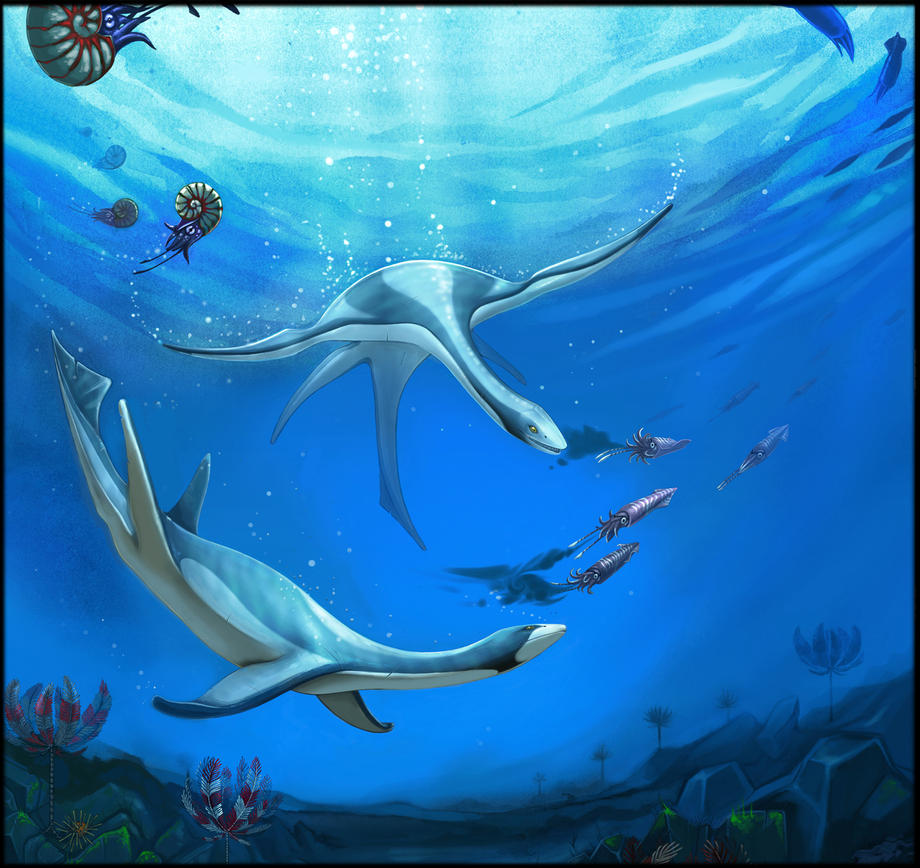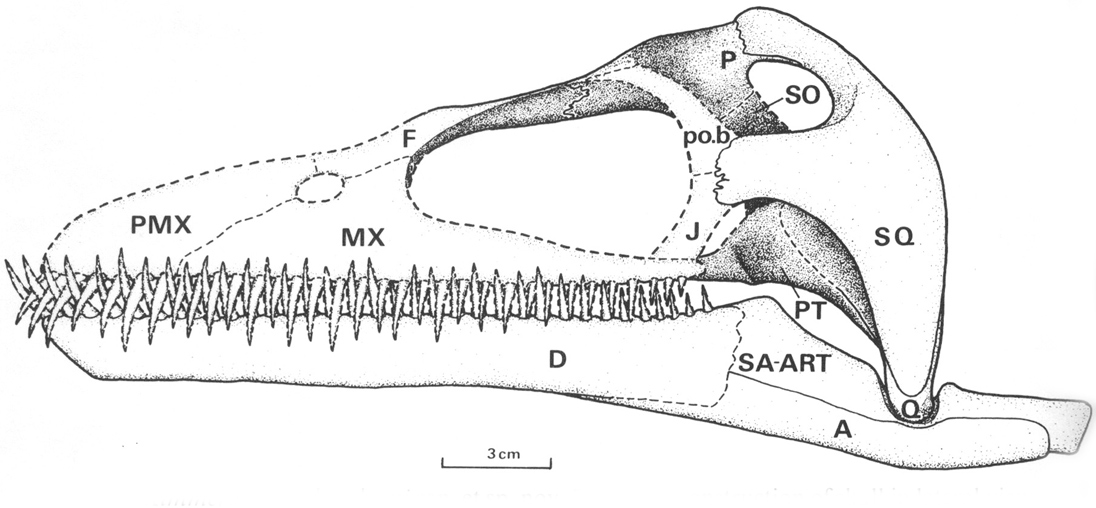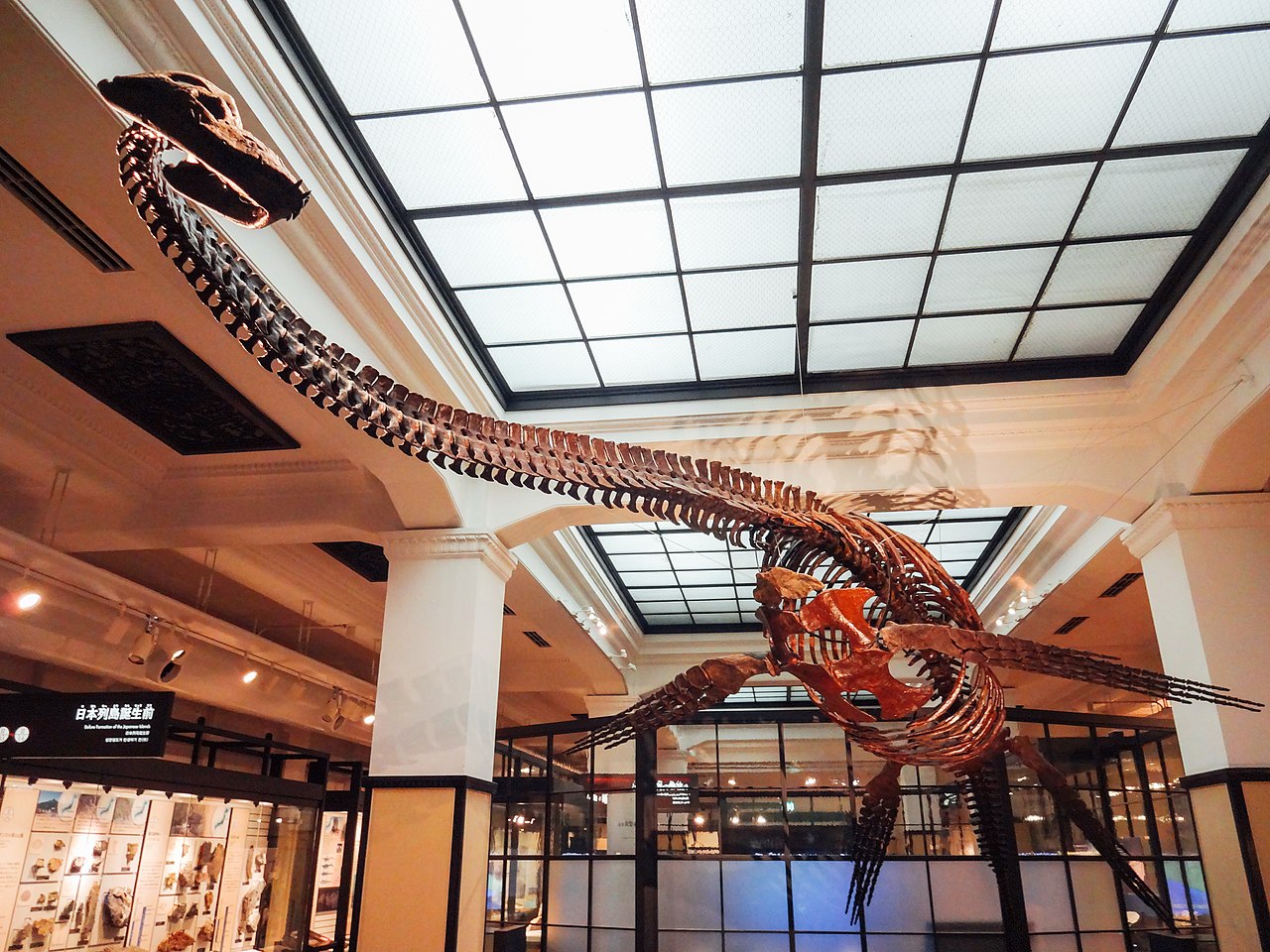Well all righty then, back to the machinations. I did get a little bit of a spike in traffic regarding my last post on Cope's purported mosasaur within an elasmosaur. As it should be because such a scenario does indeed flip the script on how we view plesiosaurs as obligate small game predators. Regardless of your opinion on the veracity of Cope's claim - indeed there are no ways to test for it at this point unless the remains are locked away in the basement of some museum - what should not have escaped your attention is that no one as far as I know has suggested that an expandable gular throat/neck tissue could have significantly enlarged the maximum food parcel swallowed by plesiosaurs. And given that expandable gular pouches/necks are quite common (and useful) in extant reptiles/diapsids I think that this is quite tenable idea. Is their any evidence of such an ability to swallow large/difficult quarry in plesiosaurs? No, not iron-clad but the following instances in this post due point to a more varied, opportunistic foraging strategy for which I consider a "mesopredator" niche the best descriptor for these animals as a whole.
Now above is a little preview of what I have in store today. The pic I stole from a little educational page on birds that predate on other animals. It is some type of cormorant with a shark... looks like a dogfish of some sort? Some might say I pick on sharks a little bit here... in actuality I like sharks quite a bit. But that does not mean that they don't have their weaknesses. Tonic immobility obviously which you can argue the above cormorant is exploiting. And with a body made for rolling plesiosaurs could likewise grab a chondricthian flip it upside down with a belly roll and have a nice sharky snack. But unlike the above cormorant, plesiosaurs (again when I use the word plesiosaur I am implying the long necked ilk) had the arsenal and attitude to dismember prey too large to swallow in one gulp. And we actually have some pretty good proof of a shark dismembering plesiosaur which seems to have went over most people's heads, including my own until I actually found the poster and read it.
Before I get to that poster I want to dive in a little bit regarding the background of the North American epicontinental Sundance Sea - the inland sea that two of the plesiosaurs I will address in this post hail from. Now the Sundance Sea never seems to get the attention of the other epicontinental sea of North America, the Western Interior Seaway, gets. There were no large sharks, bulldog fish, pteranodons, or mosasaurs. The Sundance Sea was late Jurassic in age and seems to roughly coincide with the contemporaneous Oxford Clay fauna of England. But unlike the more well known English formation with its diverse fauna of fish, marine reptiles, and invertebrates life in the Sundance appears to have been a little bit more hard-scrabble. The fish fauna was notably impoverished. Instead belemnites and ammonites seem to have formed the base of the food chain and served as the main food for the marine reptiles. Why the Sundance notably lacks fish remains is a good question. It is worth pointing out that unlike the Western Interior Seaway the Sundance did not have a southern outlet. The only entrance to it was from the north - essentially through Arctic waters. Did this northern entrance act as a bit of an ecological sieve limiting the diversity of life in the Sundance? It is also interesting to note that the famed "Pliosaur X" fauna of Spitzbergen Norway was also notably lacking in fish and dominated by cephalopods. Could it be that during the Arctic Mesozoic summer primary production shot up so high that anoxic dead zones occurred limiting fish? Something to think about...
Marine reptiles were abundant but relatively diminished in variety compared to the Oxford. There are no marine crocodile remains from the Sundance - possibly implying some sort of thermal sorting due to the Arctic entrance to this seaway. Ichthyosaurs were the most common marine reptile but represented by one genus Ophthalmosaurus natans aka Baptanodon (Marsh). Given it's large eyes and long, quick snapping jaws likely an efficient hunter of cephalopods in low light conditions. The Sundance has at least one mega-pliosaur Megalneusaurus rex which corresponds nicely with Liopleurodon both in terms of ecology and table manners. There is some relatively new info on this cryptic pliosaur pdf here. In that paper the authors note the gastric remains of this 10 meter long monster consisted of..... wait for it...... coleoid (belemnite) hooklets. Even the giants here were enjoying the calamari highlighting the opportunistic nature of many marine reptiles - a view I agree with. Also in the Megalneusaurus paper the authors (Wahl, Ross & Massare 2007) note that the Sundance marine reptile fauna consists of about 70% ichthyosaurs (1 species O. natans) to 30% plesiosaurs (2 cryptocleidoids and 1 pliosaur). Does this ratio make sense in terms of pliosaurs being macropredators and plesiosaurs filling mesopredator niches? Now most are okay with pliosaurs taking the top predator niche but the general opinion is that plesiosaurs were small prey specialists. However their relatively low abundance in this ecosystem makes sense to me if viewed as opportunistic mesopredators/scavengers. And the stomach remains of at least two Sundance long necked plesiosaurs suggest as such.
Shark eating Tatenecktes:
full pdf here
First off a little background on the mysterious Tatenecktes laramiensis. There is a paper on this little plesiosaur by O'keefe pdf online here. I was able to secure permission to use the illustration that accompanies said paper. It appears to have a novel plesiosaur bauplan: dorsoventrally compressed with pachyostosis (thick bones) in the ventral gastralia. This design, O'Keefe et. al. suggests provided stability in wave dominated, near shore environments. The body resisted rolling. This makes sense to me, especially in light of the significant shallow water habitat of the Sundance.
 |
| used w/permission (c) Spiralfish aka Helen Zhu. Tatenecktes laramiensis. March 2011 JVP |
Although cranial remains are sparse it likely had a jaw full of interlocking, meshing daggers. like it's relative Kimmerosaurus. Although the teeth are not particularly robust compared to some other plesiosaurs I have no doubt with a strong bite and leveraged by some powerful neck and shoulder muscles that could twist and shake the neck this was not an animal that you would want to suffer a bite from. Never the less it should be noted that this animal was on the lower end of tooth/skull robusticity in plesiosaurs.
But even skulls such as these were adequate for consuming small dermally armored, spine finned hybodont sharks.
 |
| Kimmerosaurus. Brown (1981) |

Wahl notes several dermal spine denticles and larger dorsal fin spine denticles within the thorax. Regarding the dorsal fin spine denticle: "The posterior bases of both spine denticles are missing and the remaining material shows some signs of having been broken off prior to deposition in the sediment. Hence, the broken spine denticle may indicate predation on the shark by the plesiosaur."
When asked Wahl himself how he thought the shark got this way via email he assumed it was dismembered by the plesiosaur. And like I have been saying it is reasonable to assume plesiosaurs could yank stuff apart together, shake it, bash it against the surface or death roll it. Or any combination there of.
 |
| Tatenecktes laramiensis bashing apart Hybodont shark. Duane Nash |
But more interestingly when Wahl discusses the possible size of the shark he mentions that based on the size of the teeth and denticle it was relatively small at less than 40 centimeters. But 40 cm puts you around 15 inches, remember the largest elasmosaurs were only supposed to have consumed fish no longer than 18 to 20 inches based on width of the back of the lower jaw. How with this pint sized (3 meter) plesiosaur eating fish close to the purported maximum prey ingested huge 14 meter elasmosaurs? Either this plesiosaur had especially wide lower jaws or it was able brake apart the shark into smaller pieces or it had an expandable gular pouch to swallow larger prey (note that these options are not mutually exclusive). Also it should be reiterated that hybodont sharks, due to their dorsal spines, pose a choking hazard. So someway by hook or crook this cute little plesiosaur ( 3 meters) swallowed the better part - and the most dangerous part - of a hybodont shark. Dorsal spines?!? who cares says Tatenecktes - hey maybe they had leatherback sea turtle throats.
Again, I have been beating the drum that there is something very wrong in terms of our traditional interpretation of plesiosaur foraging niche.
The authors also suggest that marine reptiles thwarted sharks in the Sundance Sea: "The presence of medium sized predators in large numbers (small bodied plesiosaurs and ichthyosaurs) in the Sundance formation could have kept the number of fish eating, non-reptilian vertebrates, such as sharks, to a minimum."
 |
| credit Michael Sach. CA sea lion dismembering large skate, Monterey Bay 4/9/15. www.sanctuarycruises.com |
The top pic is the new view, bottom is the older. Note how this taller more robust design offers more attachment for jaw closing muscles as opposed to the shallower skulled earlier interpretation below. Given their potentialy close relationship (cogeneric?) this is probably our best bet as to the skull of Pantosaurus until we actually get our hands on some cranial material.
But what Pantosaurus is most infamous for is being the plesiosaur that ate a voided ichthyosaur embryo (likely from our friend Ophthalamosaurus). You can read the full pdf here.
From the Discussions and Conclusions:
Ok so no evidence that a titanic battle between marine reptiles occurred with plesiosaurs ripping ichthyosaur embryos out of their mommies womb like some Cannibal Corpse song. But what we do know is that scavenging of an ichthyosaur embryo did occur by a plesiosaur. "The occurrence of the embryo in a plesiosaur gut is somewhat puzzling."The explanation most often offered is that somehow this underdeveloped, small embryo was voided from its mother in life or death and the plesiosaur scooped up and swallowed this small tid bit.
But is that the most likely explanation?
I think not.
Parsimony is a tricky thing in paleontology. For it to work you have to be aware of possible assumptions implicit in your reasoning. And, as I will argue - the implicit assumptions inherent in this scenario - is that plesiosaurs were obligately limited to small food items and had no capacity to break into and exploit larger food items and also that dead carcasses routinely "blow up" spewing embryos everywhere. And I will show that trying to explain this scenario of a plesiosaur stumbling upon and swallowing a voided embryo is a lot less likely than invoking a scenario where a plesiosaur scavenged a dead, female ichthyosaur - the mother to be of our ichthyosaur embryo.
How often do you actually just stumble upon voided embryos in the wild? I mean I go up and down beaches a lot and I find a lot of dead stuff. One beach in particular nearby kicks up a lot of dead carcasses. One time I did come upon what appeared to be a dead dolphin adjacent to an infant. Did it die giving birth?
 |
| "Mommy" Dolphin? |
 |
| ... adjacent to"Baby" Dolphin? |
So if you were cruising the Sundance Sea more than 140 million years ago where would you stand the best chance to stumble upon an ichthyosaur embryo? Just floating around in the ocean? Small, not much of a scent trail from such a small body lacking the full blood and fat volume of an adult ichthyosaur? One poor little voided embryo in all of that water?
If you ask me a better way to find an ichthyosaur embryo in the Sundance Sea would be to locate a dead pregnant Ichthyosaur. You could see it or smell it from the air or water. Anyone who has come across a putrid dead marine mammal knows the stink I am referring to. A plump bloat and float scenario. Pantosaurus could easily smell such a treat from miles a way via the wind or water. When getting closer begin to spy hop to locate the carcass. And then, if that carcass is not already coming apart at the seems simply grab and twist at the most tender parts - usually the mouth or anus in a ripe ol' carcass. Slashes lead to chunks. Getting in a little further and our slippery and slimy Pantosaurus find that the carcass is full of embryos. Quickly gobbled up by the sauropterygian undertakers they remain the only visible trace of a morbid and guttural feast on the high seas of the Sundance found by intrepid hominid paleontologist tens of millions of years later. For me stumbling upon a stinking carcass of a pregnant ichthyosaur with up to a dozen or more embryonic babies is going to be a lot more likely than stumbling upon a single small voided embryo with relatively less scent.
And then if I can direct your attention to this article on a particularly interesting set of Ichthyosaur remains: Ichthyosaur Mother Did Not Explode, Scientists Say What this article basically addresses is the commonly observed phenomena of a dead female icthyosaurs with embryos scattered in the vicinity. The prevalent idea being that carcasses blow up from internal gasses spewing embryos everywhere like gory confetti. Sound nice and lovely right? Well the researchers found out that carcasses of marine mammals don't really blow up after all (expect when some dumb apes poke 'em with stuff). So the idea that dramatic blow ups would spew embryos willy-nilly is actually a non-starter. The dispersed embryos found around adult carcasses are simple taphonomic processes such as currents moving the smaller, lighter bones of embryos around.
Again, since Mommy takes here babies with her to the grave the best place to go find embryos is not floating about but right where they were growing inside their Mommy (how many levels of morbid can I reach on this post?).
And I invoke a truism I have noticed in opportunistically minded scavengers, an ecological platitude if you will. Name me an animal that habitually scavenges - but only scavenges animals that can be swallowed whole in one bite i.e. they can not break apart larger carcasses. I can't think of one. If you scavenge at all you break big pieces down into small pieces. It might not be pretty or even that efficient but from maggot to condor they all can break down big stuff into bite sized parcels. And regardless of how the embryo got inside the plesiosaur - ripped from a carcass or picked up by luck - it is agreed this was likely a scavenging scenario.... or was it predation? Let's keep it simple today.
Because a voided embryo floating around is a harder object to locate than a dead female pregnant ichthyosaur; because ichthyosaurs had relatively large batches of pups, sometimes more than a dozen; and because bloat and floats do not actually blow up spewing embryos everywhere - I find it far more likely that this Pantosaurus was scavenging the remains of an adult dead pregnant ichthyosaur. And due to the winnowing effects of fossilization the only "hard" evidence of this occurrence are the remains of the embryo in the belly of the plesiosaur.
 |
| Duane Nash |
While there are many interesting bits in here what I want you to look at is about midway in the last paragraph;
" - while there were several pterodactyl bones, broken in small sections."
That sentence should grab your interest if you are at all familiar with the pterosaur fauna of the late Cretaceous Western Interior Seaways. You have basically three flavors Pteranodon, Geosternbergia or Nyctosaurus - while Nyctosaurus is rather modest in size - it's headgear is not. Pteranodon and Geosternbergia have outlandish headgear and are also gigantic. Seriously with as much attention that giant Azhdarchids get I think we sometimes lose respect for gigantic pteranodons. How big was the largest Pteranodon/Geosternbergia? As far as wingspan goes they seem to top off at a little over 20 feet but there are routinely claims of 22 to 24 feet for larger males - at least on wiki. How heavy? I hear estimates of anywhere from 44 to over 200 lbs. Witton puts down a weight of about 35 kg for a 7 meter wingspan pterosaur in his tome which seems like a reasonable estimate. The point here of course is that swallowing a pteranodon is no easy chore - with all those poky wing bits, sharp rostrums and fancy hadgear - it would have required dismemberment. The fact that Brown mentions that the bones were "broken in small sections" does lend credence to prey dismemberment. But according to orthodoxy plesiosaurs "only swallowed relatively small prey and could not break apart larger food items".
OR.... it was just a wee bitty baby flaplet.
 |
| Duane Nash |
As you can see in the above graphic several of these gastroliths are pretty big. If you follow the link here you can read up in greater detail on these particularly large gastroliths. 170 mm equals 6.7 inches. But mind you that is on the long axis. The largest elasmosaur were supposed to have swallowed fish no wider than 4-5 inches based on rearward width of the lower mandible. Additionally this stones show a bit of polish and wear. They are old and could have been a little bigger when first swallowed at a location 700 km (450 miles) away based on nearest source lithic locality. And these were not the largest elasmosaurs, estimated to represent an individual 9 to 12 meters long but still having swallowed gastroliths larger than Seismosaurus. So at the very least an expandable gular pouch would have been of great assistance in getting particularly large rocks down the gullet.
As I said at the beginning these cases are not entirely conclusive but still very interesting. They certainly provide enough doubt in my mind that I would not feel safe swimming with a phalanx of Futabasaurus!!
 |
| wiki. credit Dick Thomas Johnson (lol). Futabasaurus |
Well I am gonna have to leave it off right here as this post has already gotten longer than expected. I guess the same can be said regarding this series as a whole. Seriously I was originally going to do only 3 or 4 of these but as I keep writing them new and interesting topics and ideas keep bubbling up as I write more - things that deserve their own post. But that's ok I enjoy writing these and there seems to be some interest out there. Coming up mosasaurs and elasmosaurs and several ideas about the neck to be explored including a new idea I thought of last week!!
But here is your hint for the next installment: the hot dog of the ocean, imitation crab meat!!
Cheers!!
Support me on Patreon.
Like antediluvian salad on facebook.
Watch me on Deviantart @NashD1.Subscribe to my youtube channel Duane Nash.
My other blog southlandbeaver.blogspot.











1 comment:
Alas, Brown's pterosaur gut remains in a plesiosaur are considered doubtful nowadays - there's nothing especially pterosaury about them. Your timing with this post is unfortunate - I have a manuscript in review which mentions this! We know at least two types of shark ate the WIS pteranodontians, and there are some bite marks on some specimens that we've not figured out yet, but that's about it for now.
Post a Comment